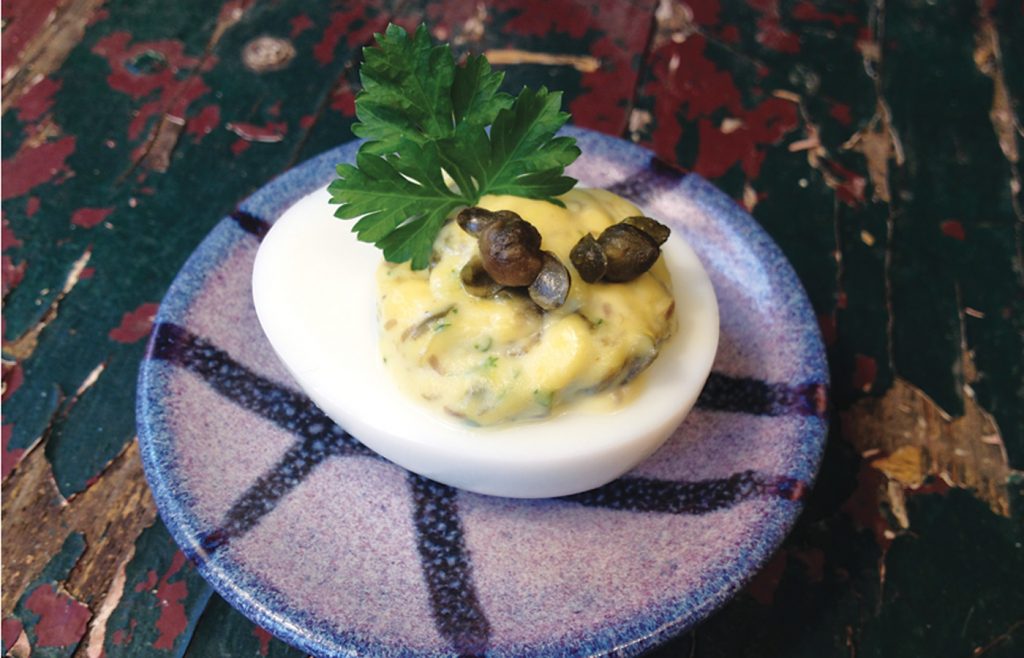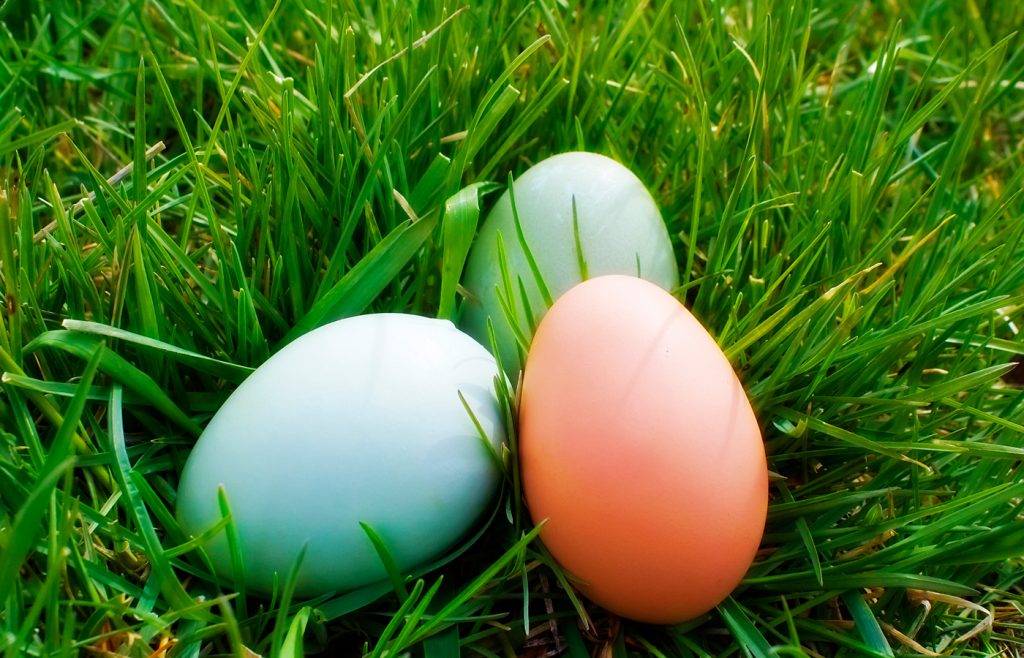
Last year at Easter time I bought a fake, white-chocolate candy version of a deviled egg at Dutchman’s Store in Cantril and set it out on the serving tray next to the real ones I’d carefully prepared at home. It was surprisingly realistic looking. Using a skillfully improvised mustard-to-mayo ratio, I had managed to get my yellow yolk filling to perfectly match the candied version, and yes, in the end, I successfully duped several of my nephews. We all had a few good laughs before deciding to cut into the fake egg to see if it was remotely edible. The verdict? Meh. The boys threw it out and went back for second helpings of the real thing.
We may have the ancient Romans to thank for some of our egg-eating habits. The roots of modern-day deviled eggs can be traced back to the appetites of wealthy Roman patricians, who enjoyed consuming boiled eggs dressed with spicy sauces at the beginning of a meal. The Romans adopted the Latin saying, “ab ovo usque ad mala,” meaning “from eggs to the apples,” or from the beginning [of a meal] to the end.
The word “deviled,” however, wasn’t used as a culinary term until 1786 in Great Britain, but by the 19th century, the term was commonly printed in reference to spicy or zesty food, which—you guessed it—included eggs lavishly adorned with mustard, pepper, or other embellishments whipped into a frenzy and crammed into the yolk cavity.
Depending on where you live and what kind of circles you run in, egg hors d’oeuvres may instead be referred to as “mimosa eggs,” “stuffed eggs,” “dressed eggs,” or even “salad eggs”—especially when served in the basement of a church. (In certain religious settings it may not be appropriate to associate your food with Satan. Especially on Easter.)

Why eggs on Easter? Traditions of dyeing, decorating, hiding, and finding eggs date back to early Christian (and even pagan) customs. The eating of eggs on Easter, however, just might stem from more practical reasons.
If you observe Lent, you may already know that dairy and eggs were traditionally forbidden in Western Christianity during this annual fast, and in some Catholic sects, still are. So picture this: While Agnes, the responsible Catholic, may have been observing an egg-free lifestyle for several weeks during Lententide, her chickens were still laying to beat the band. Come Easter, her family and friends better consume as many eggs as they can so as not to waste this delicious, fortifying foodstuff. And if, during the last days of Lent, your eggs are in danger of spoiling, boiling them just in time to preserve them for an Easter feast sounds like a pretty economical thing to do.
Christians around the world still feast on boiled egg-based dishes at Eastertime. This year maybe try a bite of spicy, eggy Spanish meat pie called hornazo, or even the Hungarian rakott krumpli, a creamy potato casserole made with oodles and oodles of boiled eggs.
My family has always done it the good ol’ American post-WWII Betty Crocker way: Miracle Whip, yellow mustard, and egg yolks get mashed up with a fork, squirted out of a plastic baggy, and served with a super sophisticated dusting of paprika. Fine dining, y’all.
Okay, if you think about it for just a second too long, deviled eggs do start to sound pretty disgusting, but even my fried-egg-resenting father can’t help himself on Easter morning. That dish is the first to disappear. And the easiest to make. Theoretically.
Many of us have had that frustrating experience an hour before Easter brunch when, after cooking and cooling, the ding-dang egg white will not separate from the blasted membrane, and getting the shell off the ever-lovin’ thing becomes an absolute nightmare. Nothing worse than crying into your sink over a dozen eggs that refuse to peel. Using them for potato salad? Fine. Egg salad? More than fine—egg salad is supposed to be lumpy. But not your precious deviled beauties.
To avoid this particular Easter upset, there are a few tricks you could adopt. Some folks swear the key is to put your eggs into the cold water before bringing them to a boil for three minutes, letting them stand covered for five more, and cooling them immediately in a bath of icy water. Others insist it’s a matter of using eggs that did not come straight out of the chicken; a little shelf sitting is a good thing! Some profess that baking soda in the water will encourage the whites to separate from the shell. My kitchen-savvy friend Nancy swears by giving the fat, round end of the egg a good square whack against the counter, forcing a pocket of air up and around the egg white. And then there is fervent prayer. Our Father, who art in heaven, hollowed be thine eggs. For the ultimate peeling experience, why not go for the gold? Try all of the above.
After all, when you are deviling eggs, you need them to be pearly, round, and smooth so the little suckers can slide around on the platter just like they were meant to—and right onto the floor of your car during transport to your uncle’s house.
If you were worried this article was going to lack substance of any kind, here’s a variation on a deviled egg recipe I discovered by New York-based culinary artist Daniel Gritzer. I wanted to ratchet up my Easter brunch experience a few notches this year, and his version sounded spectacular. If you like some tang, boy, this is the deviled egg recipe for you! (After trying this recipe, I immediately began wondering what else I could put fried capers on—or am I allowed to just eat them like popcorn?!) Happy Easter!
Deviled Eggs With Fried Capers, Lemon, and Parsley
Makes 10
1/4 cup capers, rinsed and drained (or 1/3 cup if you want to snack on some later)
2 cups canola oil
6 hard-boiled eggs, peeled and cut in half lengthwise
3 tsp. mayonnaise
1 tsp. Dijon mustard
2 tsp. juice and 1 teaspoon zest from 1 lemon
1 tsp. extra-virgin olive oil, plus more for drizzling
1 Tbsp. minced fresh parsley leaves, plus more for garnish
Freshly ground black pepper to taste
- Place capers on a double layer of paper towels. Fold towels over and press firmly to dry capers thoroughly. In a medium pot, heat oil to 350° F as registered on an instant-read thermometer. Carefully add capers and stand back (they will bubble and spit). Cook, stirring with a metal spider, until bubbling slows to a steady stream, about 30 seconds. Immediately remove capers from oil and transfer to paper towel-lined plate. Set aside.
- Place all of the yolks in a medium bowl. Select 10 of the best-looking egg white halves and set aside. Reserve the remaining 2 for another use. Add fried capers (reserving 20 as garnish), mayonnaise, mustard, lemon juice and zest, olive oil, and parsley. Using a stiff whisk, mash and stir until well combined. Season to taste with pepper.
- Transfer yolk filling to zipper-lock bag. (Filling and egg white halves can be stored in the refrigerator overnight before filling and serving. Lay egg white halves cut-side-down on a plate and cover with plastic wrap. Fried caper garnish can be stored at room temperature.) When ready to serve, cut off corner of zipper-lock bag and pipe filling into egg white halves, overstuffing each hole. Garnish with fried capers and parsley. Drizzle with olive oil and serve immediately. Zing!
